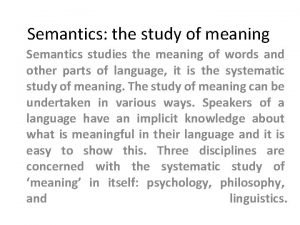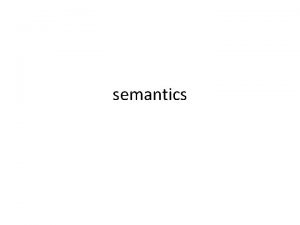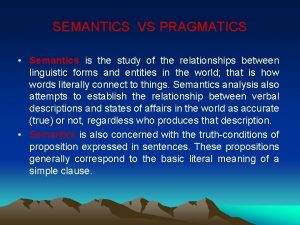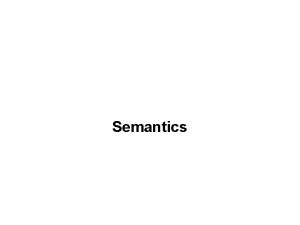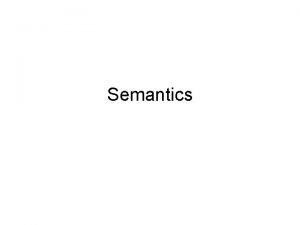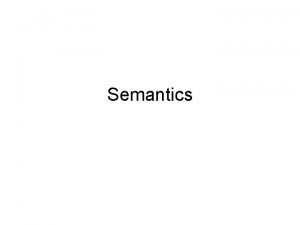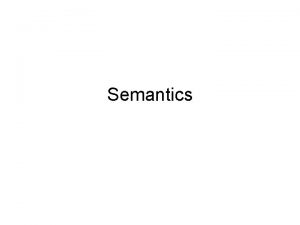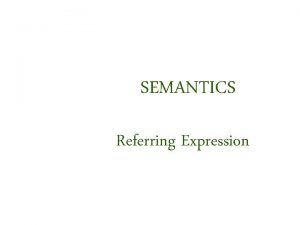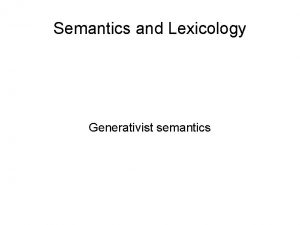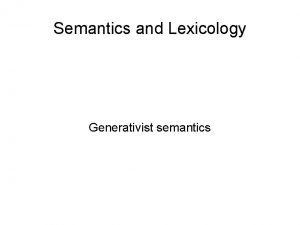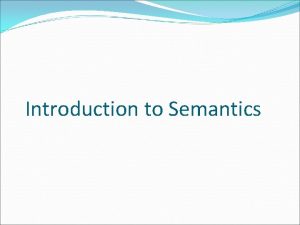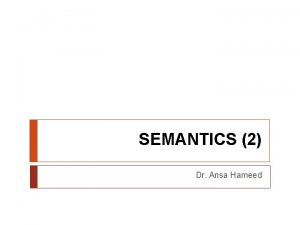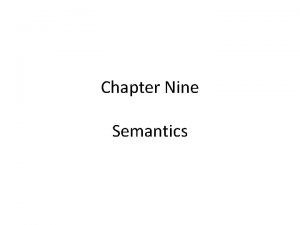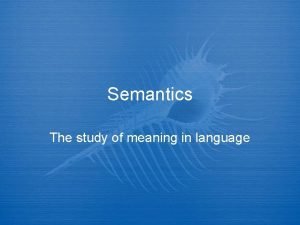SEMANTICS Definition of Semantics Semantics is the study



















- Slides: 19

SEMANTICS

Definition of Semantics • Semantics is the study of literal meanings of words, phrases and sentences. • Semantics focuses on the link between the lexicon and the grammar and semantic meaning. • Semantic meaning is the literal meaning of a word, phrase, or sentence.

Semantic Relations In everyday talk, we often explain the meanings of words in terms of their relationships. If we’re asked the meaning of the word conceal, for example, we might simply say, “It’s the same as hide”, or give the meaning of shallow as “the opposite of deep”, or the meaning of daffodil as “a kind of flower”. In doing so, we are characterizing the meaning of each word, not in terms of its component features, but in terms of its relationship to other words. This approach is used in the semantic description of language and treated as the analysis of semantic/lexical relations.

Semantic Relations • • • synonymy antonymy hypernymy ambiguity

Synonymy • Two or more words with very closely related meanings are called synonyms. • We can say, What was his answer? or What was his reply? with much the same meaning. Other common examples of synonyms are the pairs: almost/nearly, big/large, broad/wide, buy/purchase, cab/taxi, car/automobile, couch/sofa, freedom/liberty. • Synonymous forms may also differ in terms of formal versus informal uses. The sentence My father purchased a large automobile has virtually the same meaning as My dad bought a big car, with four synonymous replacements.

Antonymy • Two forms with opposite meanings are called antonyms. • Some common examples are the pairs: alive/dead, big/small, fast/slow, happy/sad, hot/cold, long/short, male/female, married/single, old/new, rich/poor, true/false.

Hyponymy • A word is a hyponym of another if its semantic meaning is more specific than the other’s. • Examples are the pairs: animal/dog, dog/poodle, vegetable/carrot, flower/rose, tree/banyan. • If an object is a rose, then it is necessarily a flower, so the meaning of rose is more specific than the meaning of flower. Rose is a hyponym of flower.

Looking at the diagram, we can say that “horse is a hyponym of animal” or “cockroach is a hyponym of insect”

Hypernymy • A word is a hypernym of another if its semantic meaning is more general than the other’s. Looking at the diagram, we can say that “animal is a hypernym of horse” or “insect is a hypernym of cockroach”

Ambiguity • A word, phrase, or sentence is ambiguous if it has multiple semantic meanings. • Bank is ambiguous (river bank or financial institution). – bat (flying creature) – bat (used in sports) – mole (on skin) – mole (small animal) – pupil (at school) – pupil (in the eye) – race (contest of speed) – race (ethnic group)

Exercise 1 Offer synonyms for the underlined words in the following sentences. 1. We saw a tiny child. 2. She hid the news from his mother and father. 3. He could not tolerate the noise. 4. He always referred to himself as a labourer. 5. Please don’t meddle with my professions

Exercise 2 Select the most appropriate antonyms for the underlined items in the following sentences. 1. My coffee is cold. 2. My feet are cold. 3. He has dark hair. 4. The sky is becoming very dark. 5. He disappeared. 6. We arrived at noon.

Exercise 3 Put the following lists into taxonomic hierarchies. 1. Rose, plant, tea-rose, dog-rose, flower, daisy 2. Tea, coffee, beverage, milk, black coffee, sugared coffee 3. Cold-blooded animals, warm-blooded animals, crocodiles, birds, fish, whales

Exercise 4 Paraphrase each of the following sentences in two ways to show that you understand the ambiguity involved. For example: Flying planes can be dangerous. ambiguous a. To fly planes can be dangerous. b. Planes which are flying can be dangerous.

1. 2. 3. 4. 5. He’s been waiting near the bank for hours. She can’t bear children. The design has big squares and circles. Gerry loves his wife and so do I. That sheep dog is too hairy to eat.

Idioms • An idiom is a group of words whose meaning cannot be explained in terms of the habitual meanings of the words that make up the piece of language. • Thus ‘fly off the handle’ which means ‘lose one’s temper’ cannot be understood in terms of the meanings of ‘fly’, ‘off’ or ‘handle’.

Idioms can be categorized as follows: 1. Alliterative comparisons e. g. dead as a dodo good as gold 2. Noun phrases e. g. a blind alley = route that leads nowhere a red letter day = a day that will never be forgotten 3. Preposition phrases e. g. at sixes and sevens = unable/unwilling to agree

4. Verb + noun phrase e. g. kick the bucket = die spill the beans = reveal a secret 5. Verb + preposition phrase e. g. be in clover = be exceptionally comfortable be between a rock and a hard place = have no room for maneuver 6. Verb + adverb e. g. give in = yield put down = kill

References Todd, Loreto. (1987). An introduction to linguistics. London: Longman York Press. Yule, George. (2006). The study of language. New York: Cambridge University Press.
 Compare procedural semantics and declarative semantics.
Compare procedural semantics and declarative semantics. Semantic studies
Semantic studies Semantics example
Semantics example Pragmatics example
Pragmatics example Hát kết hợp bộ gõ cơ thể
Hát kết hợp bộ gõ cơ thể Frameset trong html5
Frameset trong html5 Bổ thể
Bổ thể Tỉ lệ cơ thể trẻ em
Tỉ lệ cơ thể trẻ em Gấu đi như thế nào
Gấu đi như thế nào Tư thế worm breton là gì
Tư thế worm breton là gì Alleluia hat len nguoi oi
Alleluia hat len nguoi oi Các môn thể thao bắt đầu bằng tiếng bóng
Các môn thể thao bắt đầu bằng tiếng bóng Thế nào là hệ số cao nhất
Thế nào là hệ số cao nhất Các châu lục và đại dương trên thế giới
Các châu lục và đại dương trên thế giới Công của trọng lực
Công của trọng lực Trời xanh đây là của chúng ta thể thơ
Trời xanh đây là của chúng ta thể thơ Mật thư tọa độ 5x5
Mật thư tọa độ 5x5 Làm thế nào để 102-1=99
Làm thế nào để 102-1=99 độ dài liên kết
độ dài liên kết Các châu lục và đại dương trên thế giới
Các châu lục và đại dương trên thế giới

